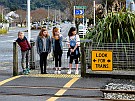<- Homepage: Rail safety: walk-drive-ride safe around rail
Experts and web conferences
Web conferences
The following questions from schools are answered by John (below) in web conference 1 about keeping train passengers and the train network safe:
- Our country is long and thin with two main islands and lots of mountain ranges so is it difficult for us to have a safe rail system?
- Is it safer to be a passenger on a train or to drive a car?
- How are modern trains designed to help keep train passengers safe in the event of a collision or a derailment or a fire?
- Like on planes, are there emergency procedures for trains? What are they? Are there signs to educate passengers?
- Why do you think people don’t go on trains more? Do you think it is more about convenience than safety?
- Who are the main players in rail safety and what are their roles e.g. passengers, train drivers, KiwiRail?
- How is good rail infrastructure important from a safety point of view? Is technology helping?
- How do you stop a train? Is there a brake?
- How many people can a train carry? What is the weight a train can carry?
- How fast can a train go and how far?
- How many passengers can a train take every year?
- What is the maximum amount of carriages a train can carry?
- What is the biggest train you have sent to somewhere?
- How many wheels does a train have? Does it have wheels?
- How many years does a train last before it rusts and doesn’t work?
- Is there a weight limit?
- What would happen if a train tipped over?
- Can we see a train today?
- How many train drivers do you need?
- How much weight does a carriage take up?
- Do you think train drivers are at risk of being replaced by technology?
- How are drivers trained?
The following questions from schools are answered by George in web conference 2 about safety on and around trains:
- Compared to 100 years ago, are people at more risk from trains?
- Apart from trains themselves, are there any other risks to people from the rail network (e.g. electrified wires)?
- If I am just a citizen who has never been a passenger on a train, how does rail safety apply to me?
- How is data informing what you do regarding rail safety? What are level crossings and are they the main focus?
- What procedures do you have to help keep people safe around trains? Are there bells and signs? Are there speed limits? Are drivers and staff trained and educated about safety?
- Is there technology such as remote cameras at level crossings? Is it helping and if so, how do you know?What potential do you see for rail in our country?
The following questions from schools are answered by Takanini School students in web conference 3 about rail safety - a student's perspective:
- In what ways do you use the railway? Do any of you catch a train to or from school? Who crosses the railway line on their way to and from school?
- What are the main areas of safety you need to think about when catching a train or crossing the railway lines? See this page for ideas - http://www.learnz.org.nz/railsafety203/discover/safey-around-trains
- What do you think is a good part of the rail system that makes it easy to be safe?
- Do you talk about rail safety at school? What sort of things do you discuss/learn about?
- Why is it important to revisit rail safety ideas, even if you catch a train or cross railway tracks often?
- If you catch a train to school, what do you enjoy about the journey?
- When you are a passenger in a car near rail, how aware are you of rail safety?
- Which of you are big fans of rail? Why?
- What would you say to people who think rail safety has nothing to do with them?
Meet the experts
Meet John from Auckland trains
Meet Peter from Auckland trains
More
- Web conference activity: Students can work on this activity while they listen to live or recorded web conferences - PDF (118k) | Google Doc. Notes from these pages could be shared to help put together the class web conference summary
- Web Conference summary: A suggested web conference summary sheet - PDF (78k) | Google Doc.




